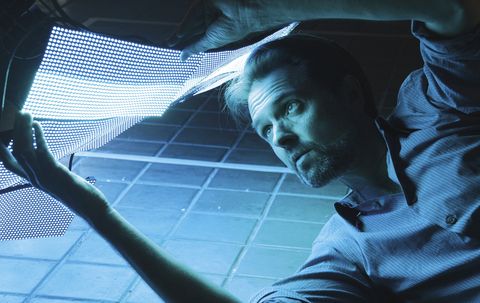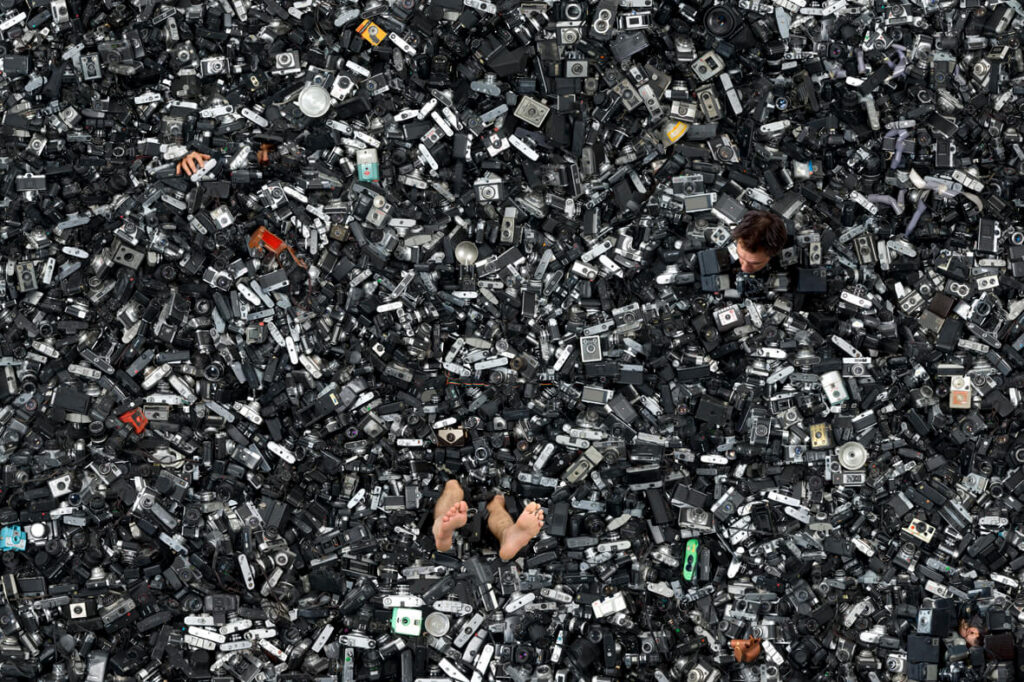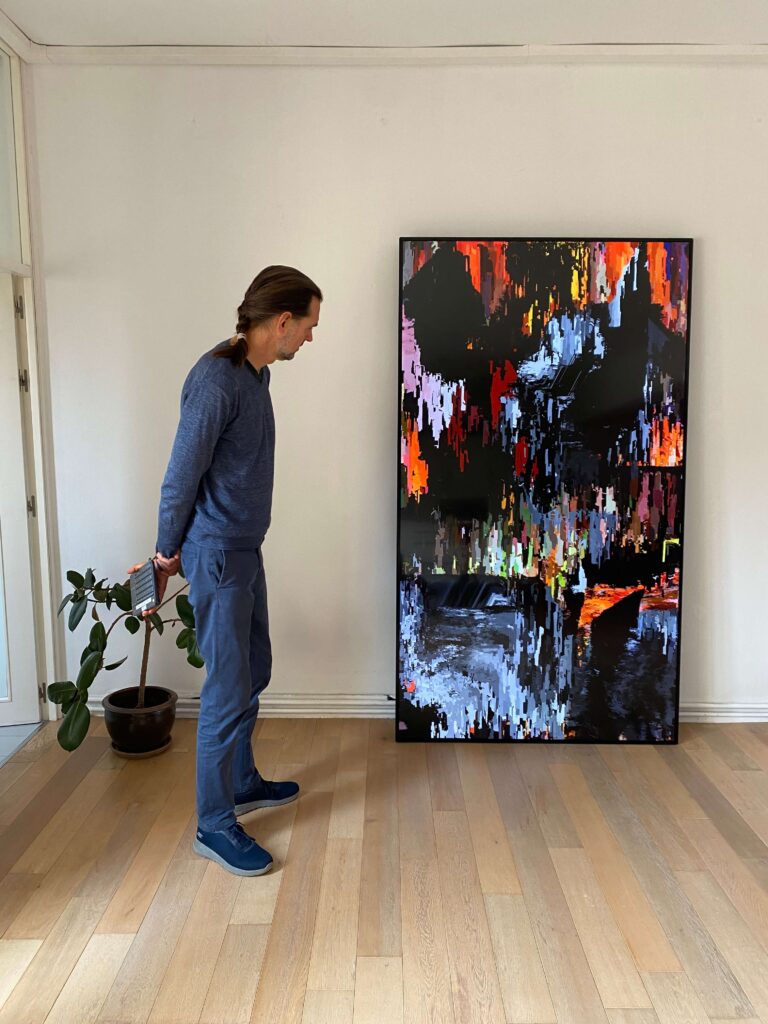Pau Waelder

The leading artist in the Spanish media art scene, Daniel Canogar‘s influential work spans almost four decades and a wide range of media from video art installations to generative software art. On the occasion of his solo artcast Liquid Data, I interviewed him in his studio in Madrid.
Light is an essential aspect of your work, not only as a way to make images visible (on screens or through projections) but also for its physical properties (diffusion, reflection) and its ephemeral nature. How would you describe the role of light in your creative process?
I think it really all goes back to me, as a 14 year old teenager, discovering the magic of the photographic darkroom. I was fortunate enough to have one in the house that I grew up, my father needed a dark room for his work. And I just kind of stumbled to this space. And before I knew it, I was totally addicted to the magic of the photographic process, in its photochemical analog version, of course, this was a long time ago.
This was a foundational artistic experience for me, that I’ve reproduced throughout my career, now through algorithms, huge projectors, in some cases, and LED screens. But I think I’m always trying to recreate that magical enchantment of a darkened space, and these glowing lights that create an almost alchemical process. One thing, that I’m also realizing is the sense of artificial darkness: this is not the darkness of night, as I’m also not using solar light. I’m using artificially created darkness, and artificially created light. And that is also my connection to technology. So there is this common thread running through 35-40 years of work, a relationship with light, which is very present throughout all my work.
Over the years you have depicted a society filled with objects, entangled in electronic networks, constantly throwing away obsolete products. How would you describe the use of accumulation and waste as a source material for your work?
I was feeling blocked, creating an artwork in a world that already has so much art, where there are so many artists producing so many art pieces. It just seemed futile to contribute another project to this ocean of projects. And it was at that time that it occurred to me to create artworks that address this sense of excess. We have too many things, and we have a hard time navigating, through the bombardment of information that we receive every day. So, the concept of excess took me to look at waste, residue, debris. I went to recycling centers, particularly interested, of course, in e-waste treatment plants. I got a lot of inspiration from just seeing the sheer amount of garbage that we generate with computers, cameras, and all kinds of electronics that we throw away too quickly.

But then I was also thinking of data, the excess of data, and thinking in many cases as data as just pure garbage. I worked with obsolete technologies, in series such as Latencies and Small Data, and other projects like Sikka, these are works that are saying goodbye to the world of material media, that has dissipated online now, restored with cloud based technologies. Before that, we had all these physical media, DVDs, DVD players, and VHS players, all kinds of electronics that populated our life until not so long ago. And I tried to give them a new opportunity, a new life, but it’s also a send off. I wanted to give them a dignified ending. Data, in a way, created these electronic ruins and is now dominating our lives. So I am trying to create a deeper understanding of the rhythms and the pulse of these kinds of systems that we have created, that seem to have a life of their own. A lot of these words are very hypnotic. I practice Transcendental Meditation now for a number of years, and this has allowed me to find some kind of inner peace, so through my work I think I’m also trying to find inner peace within this world of excess.
Generative algorithms and real time data have become an integral part of your work, that was already concerned with flows, networks and mutability. What have these technologies brought to your creative process? Have they changed how you conceive your artworks, or opened new possibilities?
When data started to become part of my artwork, a crucial change was working with algorithms to create generative art pieces. This has been an absolutely fascinating change from working with video, that is basically something that you finish, then you cut, and then is perhaps played a loop. It’s basically a finished project. Conversely, with generative art I’m suddenly liberated from this finished product, and move into something that has a life of its own. And this has been absolutely fascinating.
Coding, which is now a central aspect of my practice is perhaps, in its results, closer to performance art. It is a form of living theater, where you set the stage by encoding certain rules, but then depending on the data that’s entering the artwork, it has one behavior or another. This type of work connects with the cycles of consumption of information, of 24/7 digital broadcasting, of never reaching the end of your Instagram feed of never really getting to the bottom of your daily social media consumption, the way in the past, you would literally finish the paper newspaper, and you would close it, and that was the end of it for the day. Now, you never get that sense of a finished, completed cycle. So these generative algorithmic works, also tie in to these rhythms that are part of our daily existence. And I’m trying to understand these cycles that never end and how we become addicted to them. And how do we make sense of a world where there’s never really a sense of completion.

You have worked with regular screens, flexible LED screens, and many types of projections. What do each of these formats bring to your work and how are they integrated into the whole concept and development of each piece?
I could establish two categories of displays that I use in my work. One of them is a traditional screen, which not traditional terms of its scale but it has the presence of a canvas. The other one is the sculptural screen. From the beginning, my work has always had a desire to have an exchange between the material sculpturalness of the image, and these more ephemeral phantasmagoric, immaterial aspects of the moving image. All my work is always referencing contemporary art. My work as a media artist is about trying to think of data, of sculpture, of the history of art, in a synchronous way where it all comes together. So when I think of sculptural screens, I’m also referencing sculpture, the history of sculpture.
Now that our experience of the world is mediated by technology and a sense of constant change, how do you think we will experience art in the future?
The digital, as an intangible media that only manifests itself presently on screens is something that I would hope allows for a more active spectator. A more physically active viewer that engages with these images in a more dynamic way than we are doing right now. So despite so many discussions about the metaverse and despite all these kinds of things that we could imagine, I wish that the sentient body remains as a focal point for these experiences.
